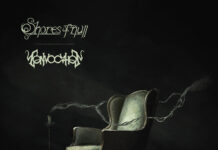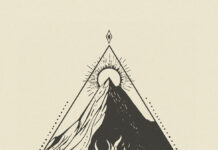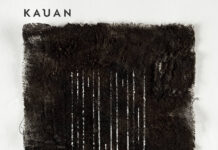“Curiosity is a real bastard,” reverberates an utterly convincing male voice against the backdrop of an ominous synth drone, and soon the soundscape is penetrated by tidal waves of swelling Blade Runner synths, while the male voice continues explaining the nature and function of curiosity as the fundamental human trait that has basically allowed the survival of humanity. Thus begins the new album “How Do You Want to Live?” by German post-rockers LONG DISTANCE CALLING, to be released on 26 June 2020, via Inside Out Music. In these unprecedented times, the question is more poignant than ever.

Curiosity can take us to new places, to some amazing experiences, and to technological innovations. It might just kill us as well, if we’re not careful. The new LONG DISTANCE CALLING album voices some beautifully composed concerns about this dichotomy, while maintaining a hopeful outlook, suggesting that technology and dystopia do not necessarily go hand-in-hand. Yes, “How Do You Want to Live?” pays homage to the dubious heritage of the 1970s prog dinosaurs: the concept album. It is a selection of ten songs that are thematically connected and mostly instrumental. So, how do you construct a concept album without lyrics? Excluding the eighth track, “Beyond Your Limits,” which features prominent hard rock-vibed vocals by Eric A. Pulverich from German rock outfit KYLES TOLONE, the album is scattered with numerous voice-over snippets that shed light on the subject. One of the most striking of these is the thought-provoking reading of the Agent Smith monologue from the classic 1999 science fiction film, “The Matrix.” It is the famous monologue that likens the human species to a virus. It creates a huge contrast to the soothing atmosphere of the album’s closer, “Ashes.”The words of Agent Smith have the potential to echo in your head, just like the delayed, percussive stabs that ripple the song’s ambient sound canvas like rocks thrown into placid water, making little sonic waves in the ether.
The themes of curiosity and technology are aptly underlined by the new electronic elements in the band’s sonic palette, which has long been characterized by melancholic guitar ostinatos and emotional crescendos. By comparison, the new album is less about the gritty bombast of post-rock riffs than the previous studio album, “Boundless,” although subtle hints of this new directions could be heard on that album already. In the meanwhile, last year the band released a live album titled “Stummfilm – Live From Hamburg.” In a way, it finished a chapter and opened a new window of opportunity for the band to redefine itself.
On this album, the textural guitar parts echo the art-rock of the early 1980s Alan Parsons Project, while the gritty riffs and swelling slides reflect the “Meddle”-era Pink Floyd. Here and there, the synth textures chime with an air similar to the vintage synthesizer, Yamaha CS80, which was prominently used by film composer Vangelis on the soundtrack of the famed 1982 Ridley Scott science fiction film “Blade Runner.” The movie still remains a prime example of dystopian narrative and the meaning of being truly human. The cinematic references are very well-matched given the theme of the album and the inherent highly evocative nature of the band’s trademark sound. Arpeggiated synth motifs and electronic beats complement the cinematic soundscapes in a way that resonates the air of the pioneering electronic downtempo artists of the 1990s, when the chillout genre was still fresh and curiously stretching to new directions. The second track on the album, “Curiosity (part 2)” fluctuates in an almost psy-trance-y pulse, slightly reminiscent of early Ozric Tentacles.
Whether a song on this album starts with an indie-rock guitar arpeggio like in ”Hazard,” or with a pulsating synth riff as in “Voices” or “Immunity,” or even with an unsettling horror movie piano like in “Sharing Thoughts,” it will soon gain momentum and explode into a crescendo of emotion; mostly the songs clock around the 6-minute mark. Excluding the opening track, “Curiosity,” which is split in two parts, just two songs keep within the radio-friendly length. The first one is the electronica-inflected “Fail/Opportunity,” which almost steps into the smokey electronica realms of 2010 BONOBO album “Black Sands” with the dialog of chime-y synths and cello. The latter is the track “True/Negative,” which creates quite an unsettling atmosphere with the use of a digitally manipulated voice-over, reciting words from the fantasy novel, “Thief of Time,” written by British satirist Terry Pratchett and menacing guitar screams, juxtaposed over the military stomp of tape-delayed electronic beats. These short, interlude-like tracks subtly suggest that the album is supposed to be listened through in one go, just like those notorious 1970s prog-rock monolith albums. Why not? The album indeed works as a collection of songs that smoothly evolve forward and bleed into one another, zooming the lens on a new facet of the album’s all-encompassing theme as they go.
Purists may not approve LONG DISTANCE CALLING to the pantheon of post-rock gods, likely on the same grounds for which they turn up their noses to GOD IS AN ASTRONAUT, for instance. Both bands play instrumental music that is highly evocative and cinematic in nature – and still rocks. You don’t have to wonder, after listening 15 minutes into the album, when the song really starts. Well, it’s true that the music is not exactly radio-friendly, but then again, quite a few great artists and bands aren’t. While instrumental music like LONG DISTANCE CALLING undoubtedly works wonders as a wallpaper-music or as the soundtrack to take the edge off the everyday grind of our lives, it definitely will prove worthwhile to pay the music its due attention. Curiosity, in this particular case, really pays off.
Written by Jani Lehtinen
Tracklist
- Curiosity (part 1)
- Curiosity (part 2)
- Hazard
- Voices
- Fail/Opportunity
- Immunity
- Sharing Thoughts
- Beyond Your Limits
- True/Negative
- Ashes
Lineup
David Jordan – Guitars
Florian Füntmann – Guitars
Janosch Rathmer – Drums
Jan Hoffmann – Bass
Label
Inside Out Music
Links
Recent posts
[recent_post_carousel design=”design-1″]





